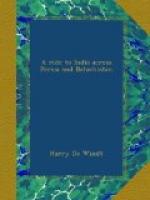I then explained with some difficulty the meaning of the word.
“Humph!” was the rejoinder. Then, with a whisk of the yellow bandanna: “I am glad I have none in Kelat!”
A mark of great favour was then shown me, the Khan presenting me with his photograph, with the request that I would show it to “Parliament” when I got home. I think he was under the impression that the latter is a human being. An incident that occurred but two years since is typical of the intelligence of the ruler of Kelat and his court. It was at Quetta, on the occasion of the presentation of Mir Khudadad to the Viceroy of India. Previous to a grand dejeuner given in his honour, the Khan and his suite were shown into a dressing-room for the purpose of washing their hands. On entering to announce that luncheon was ready, the aide-de-camp found that the distinguished guests had already commenced operations, and were greedily devouring the cakes of Pears’ soap that had been placed there for a somewhat different purpose. That none of the party felt any after ill effects speaks well for the purity of the wares of the mammoth advertiser—or the Baluch digestion!
The Khan shook my hand cordially at parting, and again begged me not to forget his warnings anent the Ameer of Afghanistan, with whom he is apparently not on the best of terms. I found, with some relief, that my Beila men had made friends with the Afghans, and, surrounded by an admiring crowd, were hobnobbing over a hissing samovar. One of the Afghans handed me a glass of tea, which, not to offend him, I drank and found delicious. It had come from China via Siberia, Samarcand, and Cabul. “Russki!” said the man with a grin, as I handed back the cup.
The Khan of Kelat very rarely leaves his palace, and is seldom seen abroad in the streets of Kelat except on Fridays, when he goes to the mosque on foot, attended by an escort armed to the teeth. He is said to live in constant dread of assassination, for his cruel, rapacious character has made him universally detested in and around the capital. His one thought in life is money and the increase of his income, which, with the yearly sum allowed him by the British Government, may be put down at considerably over L30,000 per annum. A thorough miser, the Khan does not, like most Eastern potentates, pass the hours of night surrounded by the beauties of the harem, but securely locked in with his money-bags in a small, comfortless room on the roof of his palace.
[Illustration: THE KHAN OF KELAT]
There is not the smallest doubt in my mind that Russian influence is, indirectly, being brought to bear on the Court of Kelat. But Mir Khudadad may be said to have no policy. As the French say, “Il change sa nationalite comme je change de chemise,” and is to be bought by the highest bidder.
Although the Khan’s subjects are heavily taxed, there is no protection whatsoever of life or property in or around Kelat. Theft is, according to the penal code, punished by fine and imprisonment, murder and adultery by death; but the law is subject to great modifications. In a word, the Khan is the law, and so long as a man can afford to pay or bribe him handsomely, he may commit the most heinous offences with impunity.




